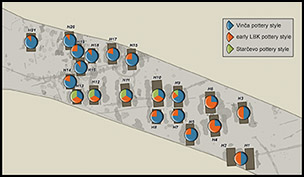Crossref Citations
This article has been cited by the following publications. This list is generated based on data provided by
Crossref.
Meadows, John
Müller-Scheeßel, Nils
Cheben, Ivan
Agerskov Rose, Helene
and
Furholt, Martin
2019.
Temporal dynamics of Linearbandkeramik houses and settlements, and their implications for detecting the environmental impact of early farming.
The Holocene,
Vol. 29,
Issue. 10,
p.
1653.
Botić, Katarina
2020.
Middle Neolithic trasformation: Starčevo–LBK–Vinča meeting point and the emergence of Ražište style in Drava river valley.
Quaternary International,
Vol. 560-561,
Issue. ,
p.
197.
Weninger, Bernhard
2020.
Barcode seriation and concepts of Gauge Theory. The 14C-Chronology of Starčevo, LBK, and early Vinča.
Quaternary International,
Vol. 560-561,
Issue. ,
p.
20.
Botić, Katarina
2020.
Judit P. Barna. The Formation of the Lengyel Culture in South-Western Transdanubia (Archaeolingua Series Maior 39. Budapest: Archaeopress, 2017, 460pp., 107 colour and 122 b/w figures, hbk, ISBN 978-615-5766-02-2).
European Journal of Archaeology,
Vol. 23,
Issue. 3,
p.
473.
Petrasch, Jörg
2020.
Settlements, migration and the break of tradition: The settlement patterns of the Earliest Bandkeramik and the LBK and the formation of a neolithic lifestyle in Western Central Europe.
Quaternary International,
Vol. 560-561,
Issue. ,
p.
248.
Oross, Krisztián
Cramp, Lucy J.E.
Gortva, Gergely
Jakucs, János
Lyublyanovics, Kyra
Marton, Tibor
Serlegi, Gábor
Vágvölgyi, Bence
and
Whittle, Alasdair
2020.
‘It's still the same old story’: The current southern Transdanubian approach to the Neolithisation process of central Europe.
Quaternary International,
Vol. 560-561,
Issue. ,
p.
154.
Depaermentier, Margaux L. C.
Kempf, Michael
Bánffy, Eszter
Alt, Kurt W.
and
Biehl, Peter F.
2020.
Tracing mobility patterns through the 6th-5th millennia BC in the Carpathian Basin with strontium and oxygen stable isotope analyses.
PLOS ONE,
Vol. 15,
Issue. 12,
p.
e0242745.
Hofmann, Robert
and
Müller-Scheeßel, Nils
2020.
Orientation of Neolithic dwellings in Central and Southeast Europe: Common denominator between the Vinča and Linearbandkeramik worlds.
Quaternary International,
Vol. 560-561,
Issue. ,
p.
142.
Chapman, John
2020.
The Vinča group - (Almost) 40 years on John Chapman (independent scholar).
Quaternary International,
Vol. 560-561,
Issue. ,
p.
5.
Jakucs, János
2020.
LBK and Vinča in South-East Transdanubia: Comments on merging, interleaving and diversity.
Quaternary International,
Vol. 560-561,
Issue. ,
p.
119.
Bayliss, Alex
Marshall, Peter
Dee, Michael W
Friedrich, Michael
Heaton, Timothy J
and
Wacker, Lukas
2020.
IntCal20 Tree Rings: An Archaeological Swot Analysis.
Radiocarbon,
Vol. 62,
Issue. 4,
p.
1045.
Bánffy, Eszter
and
Höhler-Brockmann, Hajo
2020.
Burnt daub talking: The formation of the LBK longhouse (a work hypothesis).
Quaternary International,
Vol. 560-561,
Issue. ,
p.
179.
Hamon, Caroline
and
Gomart, Louise
2021.
Social Rules and Household Interactions Within the LBK: Long-Standing Debates, New Perspectives.
Open Archaeology,
Vol. 7,
Issue. 1,
p.
690.
Furholt, Martin
2021.
Mobility and Social Change: Understanding the European Neolithic Period after the Archaeogenetic Revolution.
Journal of Archaeological Research,
Vol. 29,
Issue. 4,
p.
481.
Brehm, Nicolas
Christl, Marcus
Knowles, Timothy D. J.
Casanova, Emmanuelle
Evershed, Richard P.
Adolphi, Florian
Muscheler, Raimund
Synal, Hans-Arno
Mekhaldi, Florian
Paleari, Chiara I.
Leuschner, Hanns-Hubert
Bayliss, Alex
Nicolussi, Kurt
Pichler, Thomas
Schlüchter, Christian
Pearson, Charlotte L.
Salzer, Matthew W.
Fonti, Patrick
Nievergelt, Daniel
Hantemirov, Rashit
Brown, David M.
Usoskin, Ilya
and
Wacker, Lukas
2022.
Tree-rings reveal two strong solar proton events in 7176 and 5259 BCE.
Nature Communications,
Vol. 13,
Issue. 1,
Doumet-Serhal, Claude
Gimatzidis, Stefanos
Weninger, Bernhard
von Rüden, Constance
Kopetzky, Karin
and
Hart, John P.
2023.
An interdisciplinary approach to Iron Age Mediterranean chronology through combined archaeological and 14C-radiometric evidence from Sidon, Lebanon.
PLOS ONE,
Vol. 18,
Issue. 3,
p.
e0274979.



